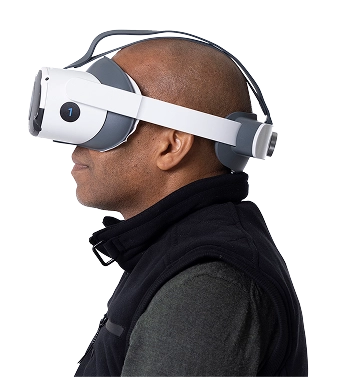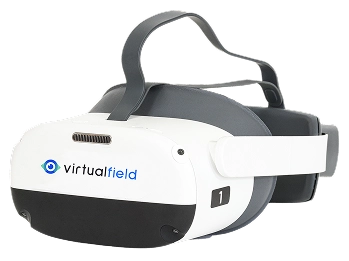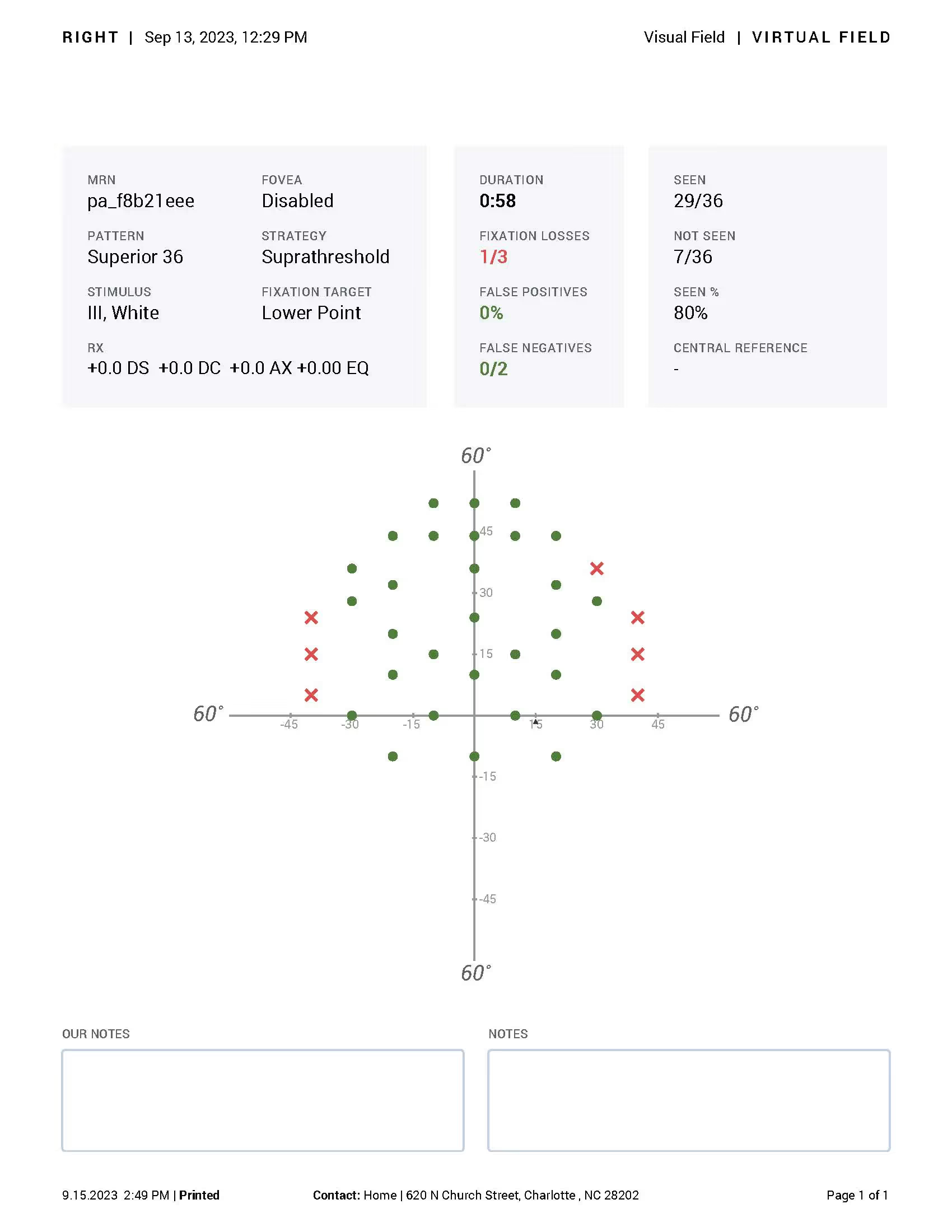The Superior 36 visual field exam may not be an everyday screening in your practice, but it plays a key role in diagnosing ptosis and supporting medical necessity for eyelid surgery visual field evaluations. Conducting even an occasional visual field test for eyelid obstruction can have a tremendous impact on your patients’ quality of life. Ptosis, or blepharoptosis, is characterized by a droopy eyelid. For many people, it’s a cosmetic complaint, but for others, it can interfere with their field of vision.
Virtual Field’s Superior 36 visual field exam is the fast, portable way to measure the impact of ptosis. Our patient-friendly headset collects the data you need to guide treatment and, if necessary, support medical necessity for oculoplastic referrals.
Superior 36 Visual Field Test for Ptosis Overview
The most obvious signs of ptosis don’t need to be identified with a specialized exam. Patients may have a visibly drooping eyelid, sometimes with a habit of raising an eyebrow to see better. They may even tilt their head to see under their weakened eyelids, which can lead to neck complaints or headaches. Blepharoptosis can be a congenital condition, but more often, it is acquired due to aging, injury, or following surgery.
For ptosis that requires surgical correction, you must complete a field of vision test for blepharoplasty. The Superior 36 is an abbreviated exam, not a complete visual field assessment, and it consists of 36 data points collected from the upper 52 degrees of the visual field.
In addition to these data points, documentation usually includes photographs of the patient’s eye and eyelid, plus a detailed description of the impact ptosis has on the patient’s quality of life. Virtual Field can collect all the photos and data you need using our portable Superior 36 screen, then upload it directly to your EHR, where you can add clinical details with ease. As a suprathreshold visual field device, Virtual Field simplifies ptosis assessment by focusing only on the relevant upper field loss while speeding up the entire process.
Academic references and clinical validation
Drooping eyelids are sometimes unnoticed or disregarded as unremarkable cosmetic complaints, but they can lead to other conditions. An older study of patients with blepharoptosis found that surgical treatment helped reduce dry eye symptoms for 86% of patients.
Treating ptosis with surgical intervention requires a specific test, like the Superior 36. CMS has outlined the definitions and requirements for intervention.
Following a Superior 36 exam, ptosis patients may find relief with drops like oxymetazoline, which is a recently approved treatment.
As part of the Virtual Field ptosis test offering, the Superior 36 makes it easy to perform targeted, insurance-aligned exams without relying on cumbersome legacy equipment.
Did You Know?
The average Virtual Field customer gets an extra 62 working hours back thanks to the workflow efficiencies from Virtual Field.
.avif)

30 days free.
No strings attached.
We are confident you’ll love Virtual Field just like the 2,000 doctors who have already made the switch.
The Superior 36 at a Glance
For patients who complain of drooping eyelids, the Superior 36 visual field test can be vital to getting them treatment. It’s a fast, simple Virtual Field ptosis test that streamlines diagnosis and supports surgical decision-making. Patients usually don’t find it fatiguing, but it can be uncomfortable if you need to tape their eyelids. It is an effective test to diagnose and guide treatment for blepharoptosis, but it’s not a complete visual field exam. The Superior 36 is available on the Virtual Field VF3 and VF3 Pro, so you can quickly access this specialized exam for any patient who struggles with their upper visual field.
Pros and Cons of the Superior 36 Visual Field Test
The pros and cons that follow can help guide you toward the ideal scenarios to incorporate this test into your patients' diagnostic assessments.
Pros
The Superior 36 is an abbreviated visual field test, so you can quickly collect information.
This test is most often required by insurers to demonstrate medical necessity for eyelid surgery.
36 data points offer quality insight into the patient’s visual field.
Cons
The Superior 36 focuses only on the superior visual field, so it’s not applicable for a complete visual field examination.
Patients who need complete visual field assessment may need additional testing.
Taping the eyelids can be awkward and uncomfortable for patients.
List of Ocular Diseases Monitored and Diagnoses Identified by the Superior 36 Exam
Ptosis (Blepharoptosis)
Drooping of the upper eyelid due to dysfunction of the levator muscle can obstruct the superior visual field. The test helps assess the degree of visual impairment caused by ptosis.
Brow Ptosis
Drooping of the eyebrow due to weakened forehead muscles, which can lead to secondary eyelid obstruction. The test helps determine if the superior visual field is compromised due to a lowered brow rather than eyelid dysfunction.

5–13%
In adults (≥40 years), acquired ptosis affects approximately 5–13% of the population
~60%
Acquired ptosis is the most common form, with age-related ptosis accounting for ~60% of cases
Pseudoptosis
A condition that mimics ptosis but is caused by other factors, such as hypotropia (a downward eye position) or a small eye. The Superior 36 test can help differentiate between true ptosis and other causes of superior field loss.
Dermatochalasis
Excessive skin on the upper eyelid that can fold over and block the superior visual field. The test helps quantify the extent of field loss due to the extra skin.
Other Conditions
Superior 36 visual field testing can also be used to monitor the impact of:
- Stroke
- Post-surgical or post-traumatic changes
- Neurogenic ptosis
- Tumors or masses
- Myasthenia gravis
- Styes
Example Superior 36 Report
30 days free.
No strings attached.
We are confident you’ll love Virtual Field just like the 2,000 doctors who have already made the switch.

Billing and Coding for Superior 36 Blepharoptosis Visual Field Testing
Using Virtual Field’s suprathreshold visual field device, you can perform the exam quickly and bill CPT code 92081 for the Superior 36 exam. This test is reimbursable between $15 and $42, depending on your practice location, setting, modifiers, and other details. Refer to the Medical Physician Fee Schedule (MPFS) for updated fees.
When is the Superior 36 visual field exam required?
Patients who complain about drooping upper eyelids due to aging or after an injury should complete the Superior 36. This test is required to demonstrate the constriction of the superior visual field, inform medical intervention, and support insurance coverage eligibility. This pre-surgical assessment can be used as a differential diagnosis for blepharoptosis, brow ptosis, dermatochalasis, and other visual field conditions. The Superior 36 is not usually used for monitoring progressive conditions, but you may conduct it more than once to follow up on ptosis treatments.
Is the Superior 36 test required for driver’s licenses?
The Superior 36 visual field exam is specifically used to diagnose and measure ptosis. It’s not relevant for driver’s licensing, but if the patient’s field of vision is highly occluded by ptosis, they may have trouble driving safely. It’s unlikely, but as part of your blepharoplasty consultation, you may discover that ptosis is limiting a patient’s field of vision below the state minimum for driver’s licensing.
Start Conducting the Superior 36 with Virtual Field
Adding the Superior 36 visual field test to your toolkit can help tick the boxes for insurance while improving outcomes for patients with drooping lids. As a portable superior 36 screen and part of the broader Virtual Field ptosis test platform, this tool allows you to collect visual field data quickly and easily, right at the point of care.
Drooping eyelids may seem minor, but they can affect vision, posture, and quality of life for some. With Virtual Field, this already-abbreviated test is even faster, more portable, and easy to integrate into your workflow. In just a few minutes, you can help justify medical interventions and improve functional vision for patients struggling with ptosis.
Want all 23 exam guides in one place?
Download our comprehensive guide for 160+ pages of insights.
FAQs
1. What makes the Superior 36 visual field pattern ideal for ptosis cases?
2. How do I perform a taped vs. untaped Superior 36 test?
3. What improvement is required for blepharoplasty approval?
4. Which CPT code should I bill?
5. How fast is the test?
6. Does Superior 36 meet AMA visual field guidelines?
Ready to get started?
Schedule a demo or begin your 30-day free trial of Virtual Field to try our EOM exam in your practice.

Questions? Contact sales@virtualfield.io talk to a Virtual Field expert today.



